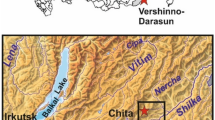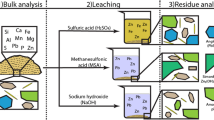Abstract
A gold deposit was exploited from 1997 to 2003 at Furtei, Sardinia (Italy). Gold and silver were recovered from oxidized ores by cyanidation; copper concentrates were separated from the sulfide ores by flotation. Following unplanned closure, sulfide-rich materials derived from mining and processing residues were left on site. During operation, cyanide solutions were disposed of in a tailings impoundment. The cyanide underwent natural degradation so that by 2011, cyanide concentrations in the tailings impoundment and seeps were below the Italian limit for industrial effluents. However, during the rainy season, sulfide-rich materials in the waste rock dumps produce extreme acidic solutions and concentrations of some dissolved contaminants, especially ammonium, aluminum, arsenic, copper, iron and manganese, still exceed discharge criteria in the tailings impoundment and seeps. Highly contaminated drainage flows downstream from the mine and poses a hazard to agricultural areas.
Zusammenfassung
Bei Furtei auf Sardinien (Italien) wurde zwischen 1997 und 2003 eine Goldlagerstätte abgebaut. Gold und Silber wurden durch Cyanidlaugung der oxidierten Erze gewonnen; Kupferkonzentrate wurden durch Flotation aus den Sulfiderzen separiert. Nach der unplanmäßigen Schließung verblieben sulfidreiche Bergematerialien sowie Aufbereitungsrückstände am Standort zurück. Während des Betriebes wurden die Cyanidlösungen in einen Schlammteich verbracht. Cyanid unterlag dem natürlichen Abbau, sodass in 2011 die Cyanidkonzentrationenen im Schlammteich sowie in den Sickerwässern den italienischen Grenzwert für Industrieabwässer unterschritten. Jedoch bilden die sulfidreichen Bergehalden während der Regenzeit extreme Sauerwässer, sodass die Konzentrationen einiger Wasserinhaltsstoffe, speziell die von Ammonium, Aluminium, Kupfer, Eisen und Mangan, im Schlammteich und in den Sickerwässern noch immer über den Einleitwerten liegen. Der hoch kontaminierte Abstrom des Bergwerks stellt eine Gefahr für landwirtschaftlich genutzte Flächen dar.
Resumen
Un depósito de oro fue explotado desde 1997 hasta 2003 en Furtei, Cerdeña (Italia). Oro y plata fueron recuperados de minerales oxidados por cianuración; los concentrados de cobre fueron separados por flotación. Tras el cierre no planificado, los materiales ricos en sulfuros derivados de los residuos de las operaciones mineras y de procesamiento, fueron dejados en el sitio. Durante la operación, las soluciones cianuradas fueron dispuestas en embalses de relaves. El cianuro fue sometido a degradación natural de modo que hacia 2011, las concentraciones de cianuro en los embalses de relaves y en los filtrados, fueron menores que los limites italianos para efluentes industriales. Sin embargo, durante la estación lluviosa, los minerales ricos en sulfuros en las escombreras de mineral estéril, producen soluciones extremadamente ácidas y con concentraciones especialmente de amonio, aluminio, arsénico, cobre, hierro y manganeso que exceden los criterios de descargo en los embalses de relaves y en las filtraciones. Ese drenaje altamente contaminado flujo corriente abajo desde la mina y representa un peligro para las áreas agrícolas.
抽象
意大利撒丁岛Furtei金矿开采时间为1997-2003年。该金矿采用氰化物氧化含金矿物的方法实现金、银提取,通过浮选法从硫化物中提取铜。当金矿闭坑时,采矿和选矿过程中产生的富含硫化物废矿石遗留于采场,残留氰化物溶液仍被圈闭于尾矿坝。至2011年,氰化物经过自然降解在尾矿坝渗出液中的浓度已经降至意大利工业废水排放标准以下。但是,在雨季,富含硫化物废矿石仍能产生强酸废水,尾矿坝渗出液溶解性污染物如铵、铝、砷、铜、铁和锰等仍然超标。从矿区向下游排放的高度污染废水对下游农业构成严重威胁。







Similar content being viewed by others
References
Botz MM, Mudder TI, Akcil AU (2005) Cyanide treatment: physical, chemical and biological processes. In: Adams MD (ed) Ch 28 in developments in mineral processing, vol 15. Elsevier, Amsterdam, pp 672–702. doi:10.1016/S0167-4528(05)15028-5
Changul C, Sutthirat C, Padmanahban G, Tongcumpou C (2010) Chemical characteristics and acid drainage assessment of mine tailings from Akara Gold mine in Thailand. Environ Earth Sci 60:1583–1595. doi:10.1007/s12665-009-0293-0
Cidu R, Caboi R, Fanfani L, Frau F (1997) Acid drainage from sulfides hosting gold mineralization (Furtei, Sardinia). Environ Geol 30:231–337
Da Pelo S, Musu E, Cidu R, Frau F, Lattanzi P (2009) Potential release of toxic elements from rocks and mine wastes at the Furtei gold mine (Sardinia, Italy). J Geochem Expl 100:142–152
GURI (2006) Decreto legislativo 3 aprile 2006, n. 152 Norme in materia ambientale. Gazzetta Ufficiale della Repubblica Italiana n. 88 del 14-4-2006, suppl. ord. n 96, parte 3, allegato 5, tab 3. Istituto Poligrafico dello Stato, Roma, Italy (in Italian)
Khodadad A, Teimoury P, Abdolahi M, Samiee A (2008) Detoxification of cyanide in a gold processing plant tailings water using calcium and sodium hypochlorite. Mine Water Environ 27(1):52–55
Nicol S, Orunesu Preiata M, Righini G, Murroni A (2002) SGM Furtei gold project: environmental management and monitoring. In: Ciccu R (ed) Proceedings of SWEMP, 7–10 Oct 2002, DIGITA Cagliari, Italy, pp 1237–1240
Parkhurst DL, Appelo CAJ (1999) User’s guide to PHREEQC (version 2)—a computer program for speciation, batch-reaction, one-dimensional transport, and inverse geochemical calculations. USGS Water-Resources Investigations Report 99–4259, Denver, CO, USA
Progemisa (2003) Caratterizzazione idrogeologica Permesso di Ricerca ‘Costa Sa Tiria’. Report Sardinia Gold Mining SpA, 28 [in Italian]
Ruggieri G, Lattanzi P, Luxoro SS, Dessì R, Benvenuti M, Tanelli G (1997) Geology, mineralogy and fluid inclusion data of the Furtei high-sulfidation gold deposit, Sardinia, Italy. Econ Geol 92:1–19
Shehong L, Baoshan Z, Jianming Z, Xiaoying Y (2005) The distribution and natural degradation of cyanide in goldmine tailings and polluted soil in arid and semiarid areas. Environ Geol 47:1150–1154
Soldán P, Pavonič M, Bouček J, Kokeš J (2001) Baia Mare accident—brief ecotoxicological report of czech experts. Ecotoxicol Environ Safety 49:255–261
Wiggins-Camacho JD, Stevenson KJ (2011) Indirect electrocatalytic degradation of cyanide at nitrogen-doped carbon nanotube electrodes. Environ Sci Technol 45:3650–3656
Zagury GJ, Oudjehanib K, Deschênes L (2004) Characterization and availability of cyanide in solid mine tailings from gold extraction plants. Sci Total Environ 320:211–224
Acknowledgments
Authors thank the former Sardinia Gold Mining, the University of Cagliari, and the Fondazione Banco di Sardegna for their financial support. Thanks also to the anonymous reviewers for their useful suggestions.
Author information
Authors and Affiliations
Corresponding author
Rights and permissions
About this article
Cite this article
Cidu, R., Da Pelo, S. & Frau, F. Legacy of Cyanide and ARD at a Low-Scale Gold Mine (Furtei, Italy). Mine Water Environ 32, 74–83 (2013). https://doi.org/10.1007/s10230-012-0209-1
Received:
Accepted:
Published:
Issue Date:
DOI: https://doi.org/10.1007/s10230-012-0209-1




